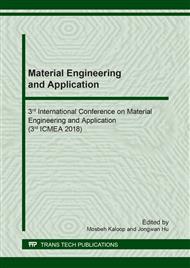p.150
p.155
p.161
p.170
p.176
p.182
p.187
p.195
p.201
A Study on the Flow Characteristics and Quality Control of Lightweight Foamed Magnesia Composite Using Super Absorbent Polymers as Base Material for Biological Panels
Abstract:
In this paper, the flow characteristics of a lightweight formed magnesia composite usingsuper absorbent polymer as base material for biological panels were evaluated. The experimentalparameters were evaluated with respect to the flow of the mortar according to the water binder ratio(W/B), the volume ratio of fine aggregate (Vs/Vm), the amount of foaming agent (FM) and theamount of super absorbent polymer (SAP). Statistical analysis was performed on the flow obtainedthrough the experiment and the influence coefficient on the flow quality was obtained. The flowquality prediction model equation of the magnesia composite is proposed through the obtainedinfluence coefficient. The proposed model equation shows that the experimental and predicted valuesare over 90%.
Info:
Periodical:
Pages:
176-181
Citation:
Online since:
November 2018
Authors:
Keywords:
Price:
Сopyright:
© 2018 Trans Tech Publications Ltd. All Rights Reserved
Share:
Citation:


